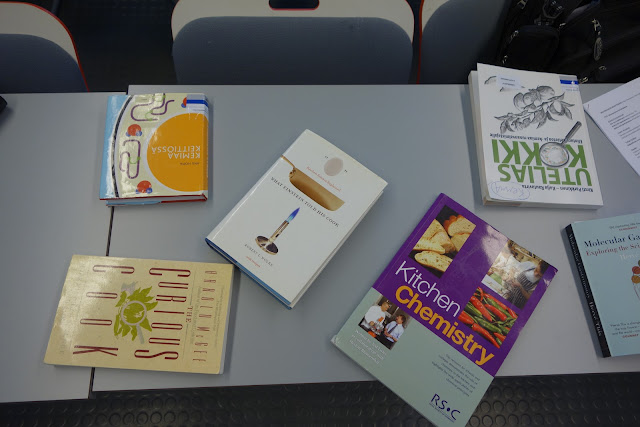What do you get when you put home economics teachers, chemistry teachers, food scientists and chefs together? A very interesting day!
I'm spending today and tomorrow at the LUMA Centre at the University of Helsinki, which focuses on promoting the natural sciences, mathematics, technology and computer science for all levels of education. They work together with students, teachers, scientists and industry professionals to make science relatable to all people and make it interesting. Last year the LUMA Centre had more than 3,000 visitors to their chemistry lab with the central focus of making these topics more interesting. From the looks on the children's faces who are here today, I'd say it is working.

When I first arrived, primary school students were in the lab making "sugar rainbows," which are columns of colorful layers of sugar water - where the layers at the bottom are more dense (more sugar) than the ones above it, so the students can see how density affects the liquid's placement in the column. (May I say how difficult it is to get photographs of students working with test tubes without getting their faces? They don't stay still very long and their heads are moving back and forth and the test tube is up and down and people walk in front and around you. :)
Concurrently, teams of home economics and chemistry teachers from the lower secondary (middle school) level were meeting to write cooking lessons that incorporated chemistry into the learning of their students. The teachers also had the chance to make the "sugar rainbows" and but their task was not just to see it, but to think about what drinks could be made using these concepts in home economics class. In this way, students can apply what they have learned about density and make themselves a drink.
These teachers are in the midst of a three-year project to combine chemistry and cooking in the lower secondary level of school (middle school in the U.S.). The teachers had previously identified ten themes for their studies and were working on learning, and applying, the chemistry behind these themes. For example, when the teachers studied emulsions, a chef came to the university and talked with them about sauces, they studied the chemistry behind the sauces, then they made the sauces and ate them! For protein chemistry, they focused on the chemistry of cooking proteins, what could be made using eggs (because meat is too expensive for a school lab), and what would be easy to cook in a school. For foams they discussed the chemistry behind meringues, and of course, made them and ate them, too! At this point in the project, the teachers are busy applying what they had learned in their studies to making curriculum for their students.

I had a long discussion with Anu Hopia, a food chemist, and she discussed in greater detail the chemistry of food and its connection with culinary arts. She thinks this approach is a good way to introduce basic science phenomenon because it interests them and it helps them apply chemistry into everyday events.
We talked about the different ways a baked potato can be cooked - by baking it in the oven with or without aluminum foil, or baking it in the oven surrounded by salt, or cooking in the microwave. Each of these methods affects the taste, structure, and texture of the potato.
The heating patterns of a potato cooked in a microwave oven.
What happens to heat when a potato is wrapped in foil and cooked in a conventional oven.
In another example teacher students compared the taste of vegetables that were sautéed (or not) before they were put into soup. Anu said people can detect very small differences in preparations and therefore by evaluating food in this way, people learn to truly taste the food and appreciate it.

There were several books available for the teachers to use in their research for their curricular project, as well as the Internet, of course, but her highest recommendation was a book by the San Francisco author, Harold McGee.
If you would like to see more about Anu Hopia's work, her blog can be found at www.molekyyligastronomia.fi . (For the "Translated to English" version, CLICK HERE.)
Tomorrow I will be joining these home economics and chemistry teachers in a kitchen in downtown Helsinki. We'll see what they create!
A big thank you to Sakari Tolppanen for such an articulate and interesting interview today about scientific problem solving and how he teaches the concept of sustainability. Kiitos!
A sign on the front of the university restaurant.










Wow! What an amazing gathering. I saw this first time which is unmatched combination. Thanks for share the knowledge and keep it up.
ReplyDeletePersonal Chef Certification